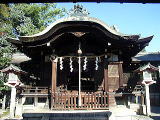Outline
*Foundedn in 859 by the Emperor Seiwa
*Built at the site of the Emperor Saga's villa (Rikyu)
*Hinotosai-Festival (Spring Festival) started about 1130 years ago
*This is the birthe place of EGOMA (labiate) oil making in Japan

Enshrined Deities
*The great deity of Sakatoke
*Emperor Ojin
*Three daughers of Emperor Ojin
and many more
Legendary Shrine History
At the begining of the Heian era(794-1185), the Emperor Seiwa ordered Gyokyo, a budist priest, to remove the debine symbol of the Usa-Hachimangu from Kyushu, and enshrine it somewhere right place in Kyoto.
When Gyokyo stopped by Yamazaki, he saw that a holy light emanated from the mountain at night. He dug at the place then found spring water gushing out of a rock.
He decided to enshrine the god there and later, a shrine was built for the prosperity of Japan.
Rikyu-Hachimangu was originally named "Iwashimizu (=spring water)-Hachimangu".
Today, however, it is called "Rikyu(=Emperor Saga's villa)-Hachimangu". It because the shrine was built at the site of the Emperor Saga's villa.
As the Birth Place of EGOMA(=labiate) oil making
At the end of the Heian era, the shinto priests of the Rikyu-Hachimangu invented an apparatus called "Nagaki" to making oil by squeezing Egoma.
Egoma is labiate.
At first, Egoma oil was used for lighting up the Imperial Court, shrines and temples. Then gradually it spread and come to used by the general public.
With the Changes of the times...
Rikyu-Hachimangu was in full flourish as Aburaza.
In 1864, however, most of the buildings were burned because of a war.
Furthermore in Meiji era (1864-1912), the national railroad was constructed at the site of the shrine. A scale of the shrine was reduced into almost a half.
Only the southern half part of the shrine remains today.
*Foundedn in 859 by the Emperor Seiwa
*Built at the site of the Emperor Saga's villa (Rikyu)
*Hinotosai-Festival (Spring Festival) started about 1130 years ago
*This is the birthe place of EGOMA (labiate) oil making in Japan

Enshrined Deities
*The great deity of Sakatoke
*Emperor Ojin
*Three daughers of Emperor Ojin
and many more
Legendary Shrine History
At the begining of the Heian era(794-1185), the Emperor Seiwa ordered Gyokyo, a budist priest, to remove the debine symbol of the Usa-Hachimangu from Kyushu, and enshrine it somewhere right place in Kyoto.
When Gyokyo stopped by Yamazaki, he saw that a holy light emanated from the mountain at night. He dug at the place then found spring water gushing out of a rock.
He decided to enshrine the god there and later, a shrine was built for the prosperity of Japan.
Rikyu-Hachimangu was originally named "Iwashimizu (=spring water)-Hachimangu".
Today, however, it is called "Rikyu(=Emperor Saga's villa)-Hachimangu". It because the shrine was built at the site of the Emperor Saga's villa.
As the Birth Place of EGOMA(=labiate) oil making
At the end of the Heian era, the shinto priests of the Rikyu-Hachimangu invented an apparatus called "Nagaki" to making oil by squeezing Egoma.
Egoma is labiate.
At first, Egoma oil was used for lighting up the Imperial Court, shrines and temples. Then gradually it spread and come to used by the general public.
With the Changes of the times...
Rikyu-Hachimangu was in full flourish as Aburaza.
In 1864, however, most of the buildings were burned because of a war.
Furthermore in Meiji era (1864-1912), the national railroad was constructed at the site of the shrine. A scale of the shrine was reduced into almost a half.
Only the southern half part of the shrine remains today.